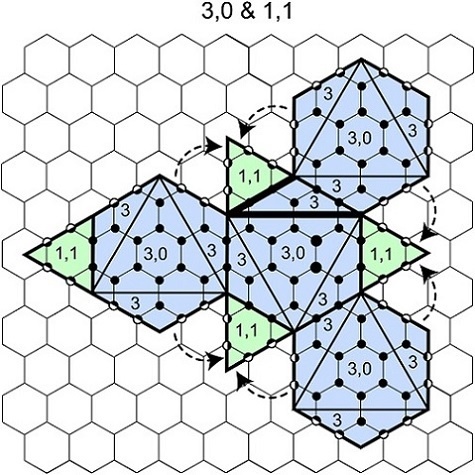Decoration of the Truncated Tetrahedron—An Archimedean Polyhedron—To Produce a New Class of Convex Equilateral Polyhedra with Tetrahedral Symmetry
Abstract
:1. Introduction
2. Materials and Methods
3. Results
3.1. Decoration of an Archimedean Polyhedron to Produce New Cages
3.2. Two Series of the New Td Cages
3.3. Production of Equilateral Polyhedra from the New Td Cages
4. Discussion
5. Conclusions
Supplementary Materials
Acknowledgments
Author Contributions
Conflicts of Interest
References
- Cromwell, P.R. Polyhedra; Cambridge University Press: Cambridge, UK, 1997. [Google Scholar]
- Kepler, J. Strena, seu de Nive Sexangula Tthe Six-Cornered Snowflake; Godefridum Tambach: Francofurti ad Moenum, UK, 1611; English translation: Hardie, C. The Six-Cornered Snowflake; Clarendon Press: Oxford, UK, 1966. [Google Scholar]
- Schein, S.; Gayed, J. A new class of convex equilateral polyhedra with polyhedral symmetry related to fullerenes and viruses. Proc. Natl. Acad. Sci. USA 2014, 111, 2920–2925. [Google Scholar] [CrossRef] [PubMed]
- Coxeter, H.S.M. Introduction to Geometry, 2nd ed.; Wiley: New York, NY, USA, 1969. [Google Scholar]
- Grünbaum, B. Convex Polytopes, 2nd ed.; Springer: New York, NY, USA, 2003. [Google Scholar]
- Caspar, D.L.; Klug, A. Physical Principles in the Construction of Regular Viruses. Cold Spring Harb. Symp. Quant. Biol. 1962, 27, 1–24. [Google Scholar] [CrossRef] [PubMed]
- Goldberg, M. A Class of Multi-Symmetric Polyhedra. Tohoku Math. J. 1937, 43, 104–108. [Google Scholar]
- Coxeter, H.S.M. Virus Macromolecules and Geodesic Domes. In A Spectrum of Mathematics; Forder, H.G., Butcher, J.C., Eds.; Auckland University Press/Oxford University Press: Oxford, UK, 1971; pp. 98–107. [Google Scholar]
- Fowler, P.W.; Manolopoulos, D.E. An Atlas of Fullerenes; Clarendon Press: Oxford, UK, 1995. [Google Scholar]
- Dutour, M.; Deza, M. Goldberg–Coxeter construction for 3- and 4-valent plane graphs. Electron. J. Comb. 2004, 11, 20–68. [Google Scholar]
- Brinkmann, G.; Friedrichs, O.D.; Lisken, S.; Peeters, A.; Van Cleemput, N. CaGe—A Virtual Environment for Studying Some Special Classes of Plane Graphs—An Update. Match-Commun. Math. Comput. 2010, 63, 533–552. [Google Scholar]
- Hehre, W.; Ohlinger, S. Spartan’10 for Windows, Macintosh and Linux: Tutorial and User’s Guide; Wavefunction, Inc.: Irvine, CA, USA, 2011. [Google Scholar]
- Pettersen, E.F.; Goddard, T.D.; Huang, C.C.; Couch, G.S.; Greenblatt, D.M.; Meng, E.C.; Ferrin, T.E. UCSF chimera—A visualization system for exploratory research and analysis. J. Comput. Chem. 2004, 25, 1605–1612. [Google Scholar] [CrossRef] [PubMed]
- Fowler, P.W.; Cremona, J.E.; Steer, J.I. Systematics of bonding in non-icosahedral carbon clusters. Theor. Chim. Acta 1988, 73, 1–26. [Google Scholar] [CrossRef]
- Kroto, H.W.; Heath, J.R.; O’Brien, S.C.; Curl, R.F.; Smalley, R.E. C60: Buckminsterfullerene. Nature 1985, 318, 162–163. [Google Scholar] [CrossRef]
- Björck, A. Numerical Methods for Least Squares Problems; SIAM: Philadelphia, PA, USA, 1996. [Google Scholar]
- Pawley, G.S. Plane Groups on Polyhedra. Acta Crystallogr. 1962, 15, 49–53. [Google Scholar] [CrossRef]

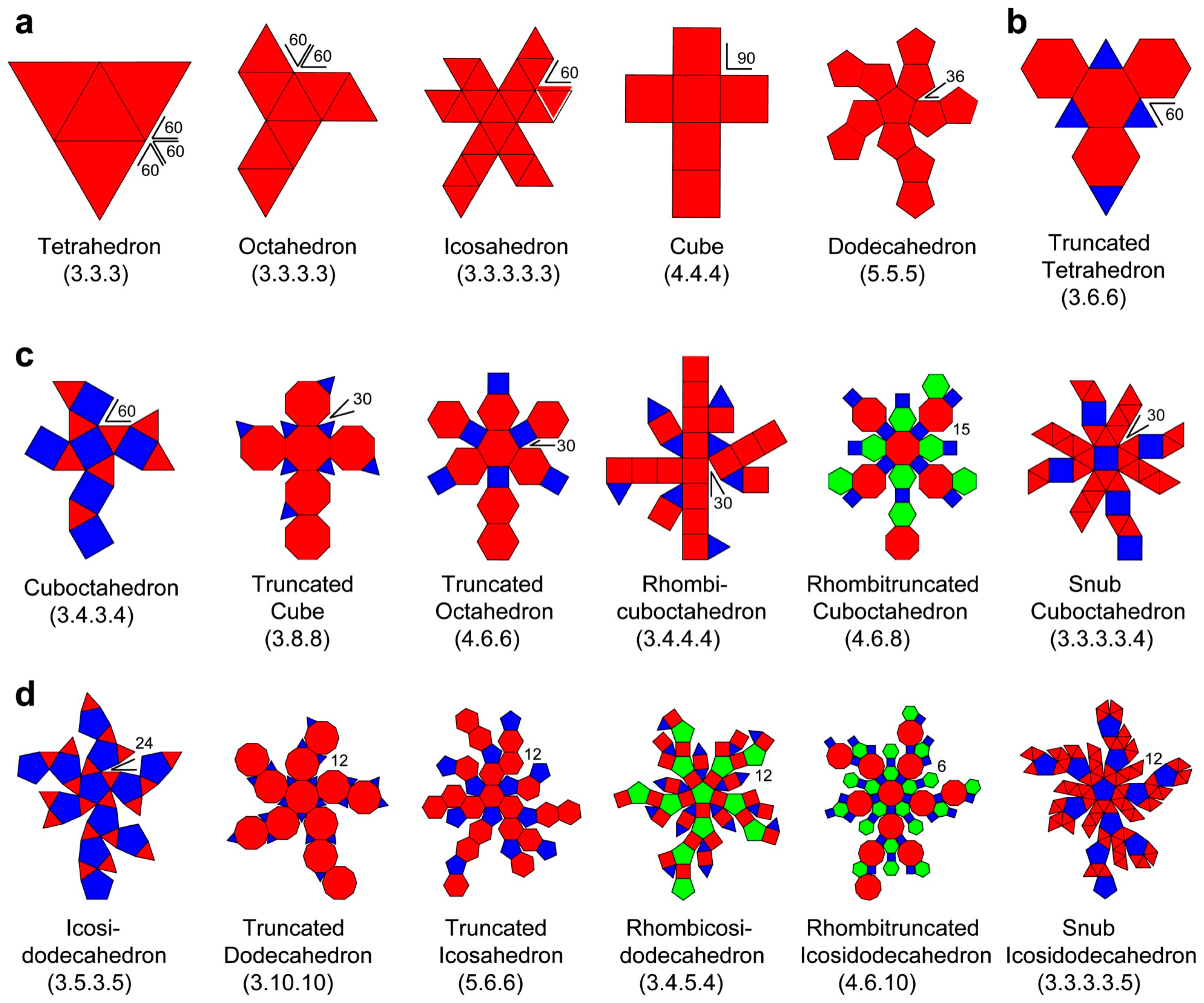
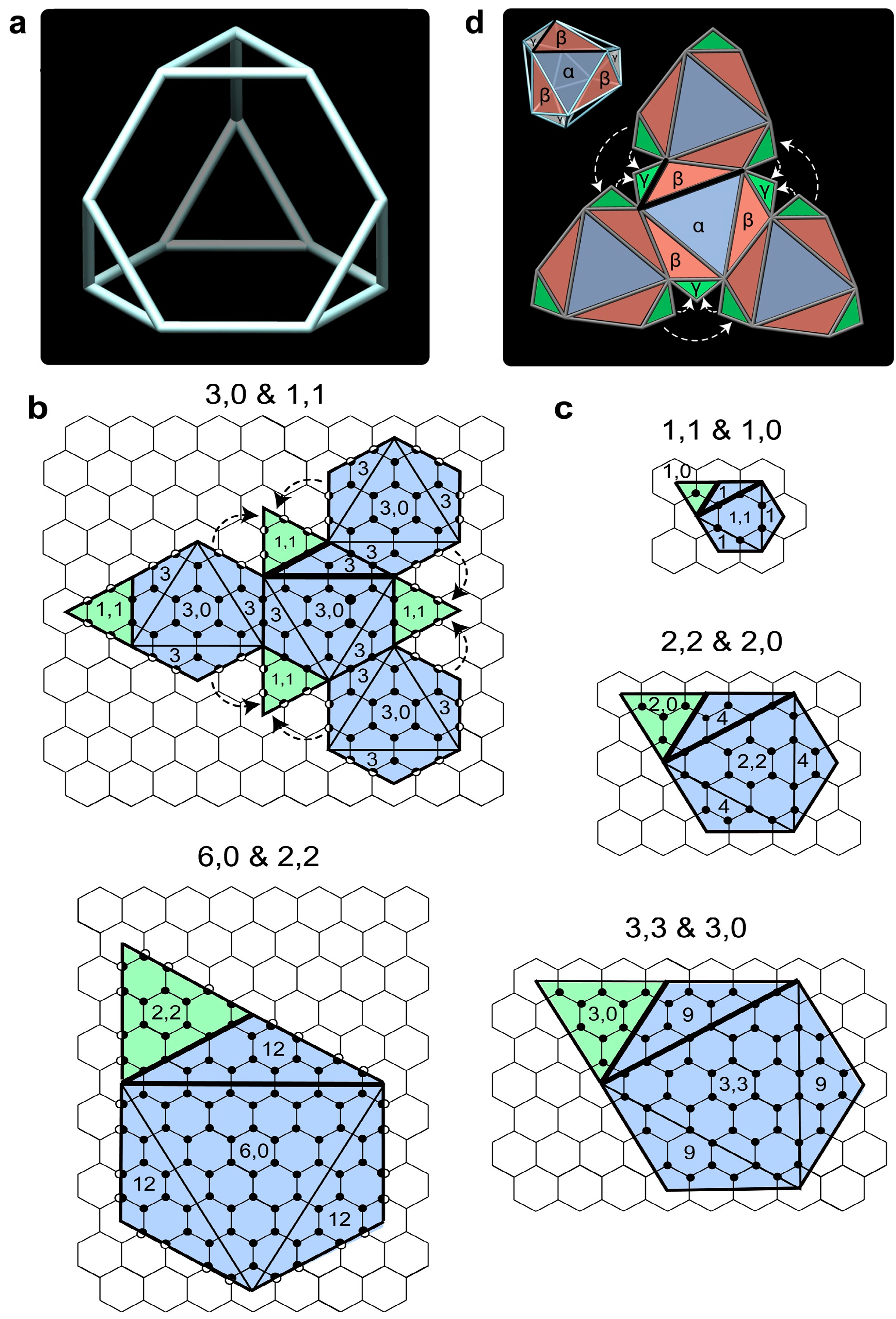
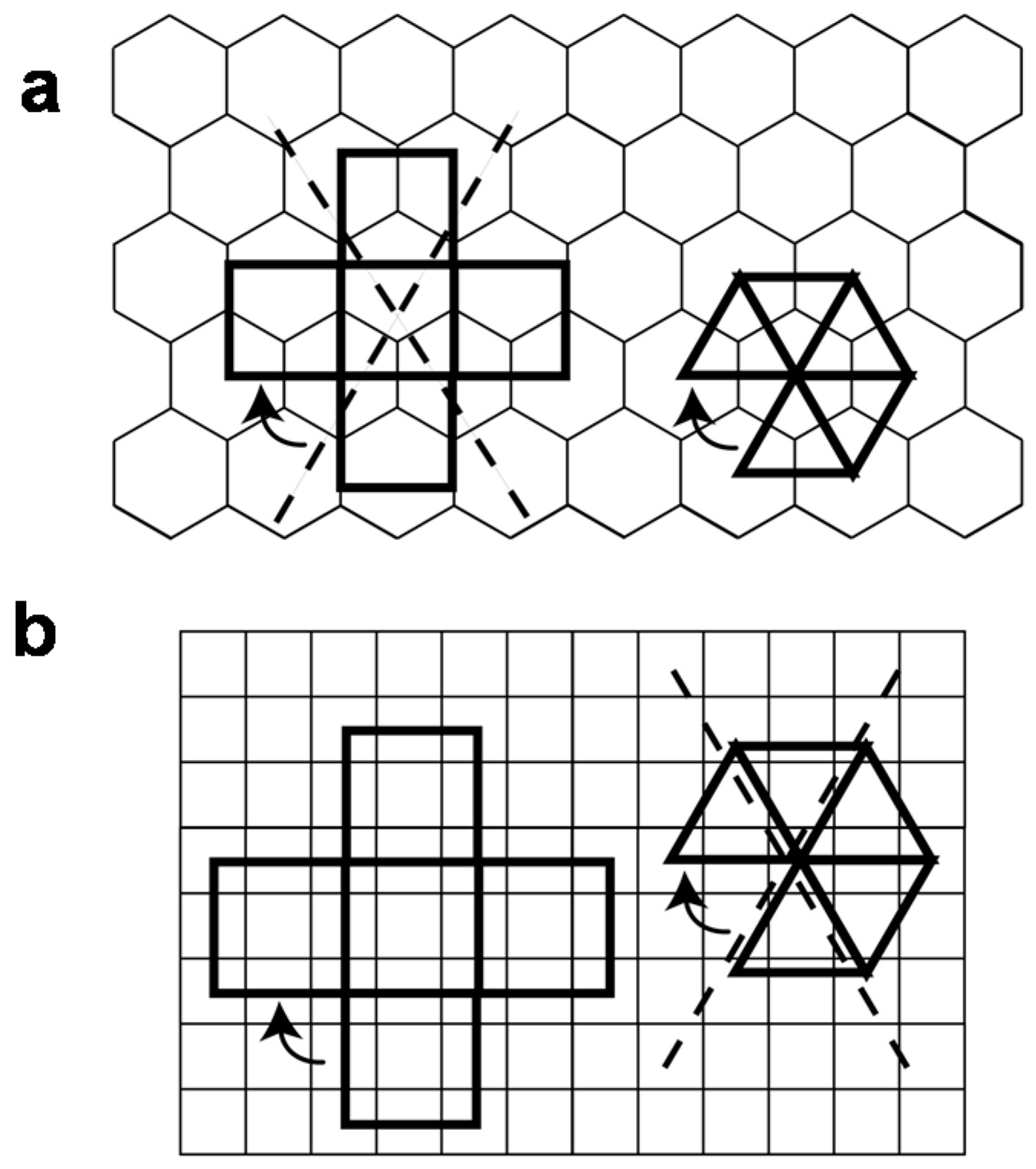
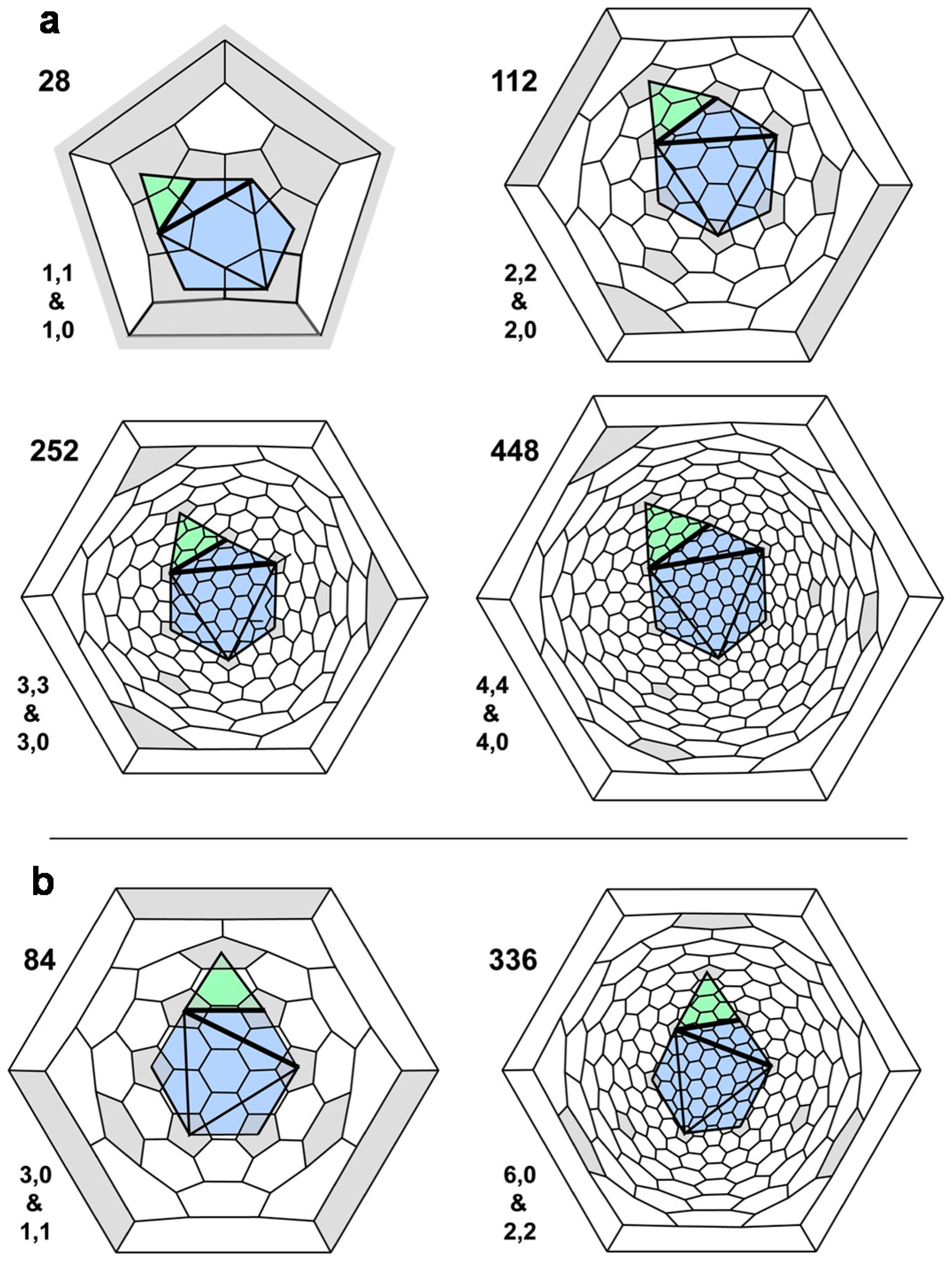
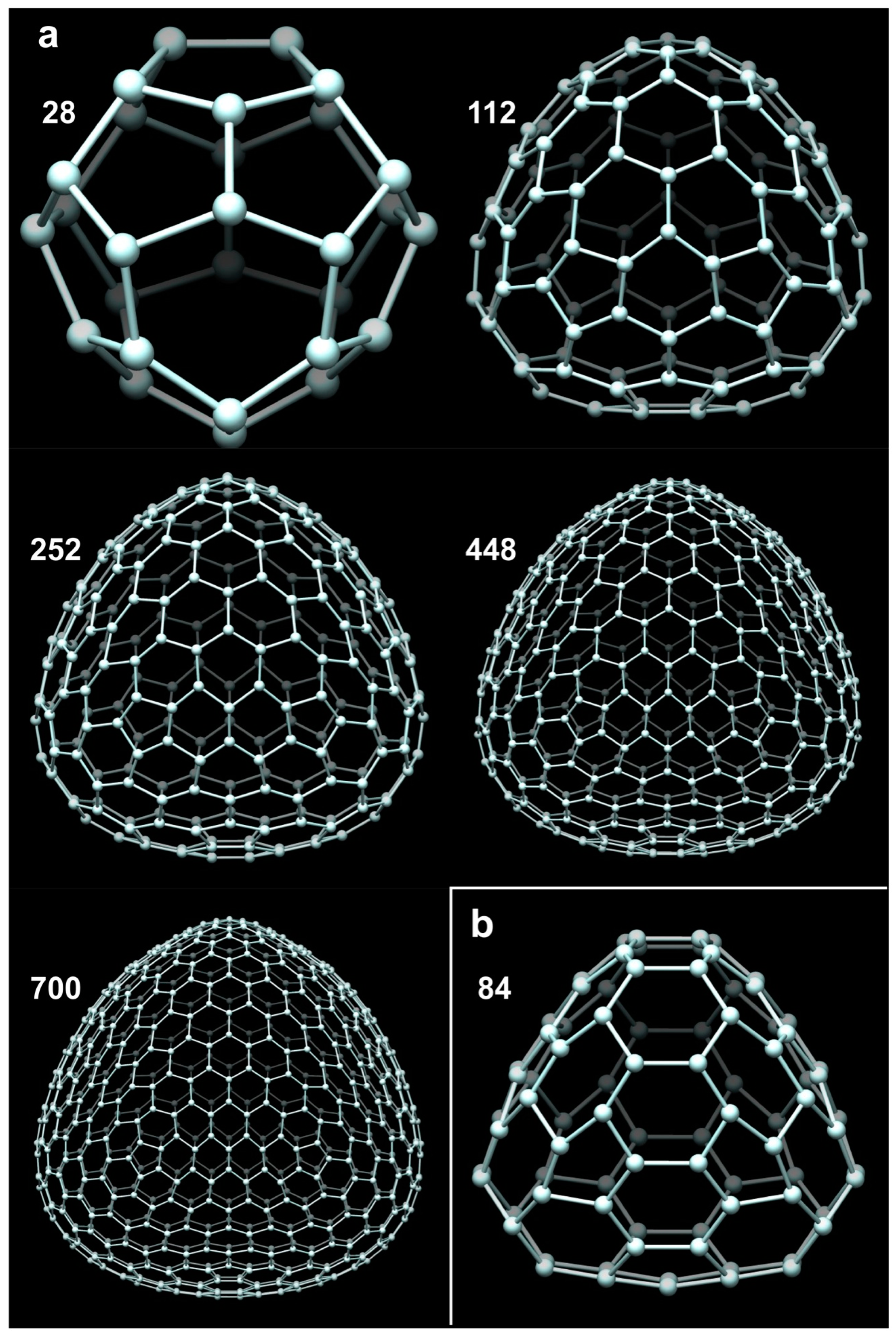
| Large Equilateral | Small Equilateral | Scalene | Total Vertices | Equilateral | |||||
|---|---|---|---|---|---|---|---|---|---|
| Triangle | Triangle | Triangle | Polyhedron | ||||||
| i | j | Vertices | k | l | Vertices | Vertices | + or − | ||
| 1 | 1 | 3 | 1 | 0 | 1 | 1 | 28 | 1 × 28 | + |
| 2 | 2 | 12 | 2 | 0 | 4 | 4 | 112 | 4 × 28 | + |
| 3 | 3 | 27 | 3 | 0 | 9 | 9 | 252 | 9 × 28 | + |
| 4 | 4 | 48 | 4 | 0 | 16 | 16 | 448 | 16 × 28 | + |
| 5 | 5 | 75 | 5 | 0 | 25 | 25 | 700 | 25 × 28 | + |
| 6 | 6 | 108 | 6 | 0 | 36 | 36 | 1008 | 36 × 28 | + |
| 7 | 7 | 147 | 7 | 0 | 49 | 49 | 1372 | 49 × 28 | + |
| 8 | 8 | 192 | 8 | 0 | 64 | 64 | 1792 | 64 × 28 | + |
| 9 | 9 | 243 | 9 | 0 | 81 | 81 | 2268 | 81 × 28 | + |
| 10 | 10 | 300 | 10 | 0 | 100 | 100 | 2800 | 100 × 28 | too large |
| 3 | 0 | 9 | 1 | 1 | 3 | 3 | 84 | 1 × 3 × 28 | + |
| 6 | 0 | 36 | 2 | 2 | 12 | 12 | 336 | 4 × 3 × 28 | − |
| 9 | 0 | 81 | 3 | 3 | 27 | 27 | 756 | 9 × 3 × 28 | − |
| 12 | 0 | 144 | 4 | 4 | 48 | 48 | 1344 | 16 × 3 × 28 | − |
| 15 | 0 | 225 | 5 | 5 | 75 | 75 | 2100 | 25 × 3 × 28 | − |
| 18 | 0 | 324 | 6 | 6 | 108 | 108 | 3024 | 36 × 3 × 28 | too large |
| 21 | 0 | 441 | 7 | 7 | 147 | 147 | 4116 | 49 × 3 × 28 | too large |
| 24 | 0 | 576 | 8 | 8 | 192 | 192 | 5376 | 64 × 3 × 28 | too large |
| 27 | 0 | 729 | 9 | 9 | 243 | 243 | 6804 | 81 × 3 × 28 | too large |
| 30 | 0 | 900 | 10 | 10 | 300 | 300 | 8400 | 100 × 3 × 28 | too large |
© 2016 by the authors; licensee MDPI, Basel, Switzerland. This article is an open access article distributed under the terms and conditions of the Creative Commons Attribution (CC-BY) license (http://creativecommons.org/licenses/by/4.0/).
Share and Cite
Schein, S.; Yeh, A.J.; Coolsaet, K.; Gayed, J.M. Decoration of the Truncated Tetrahedron—An Archimedean Polyhedron—To Produce a New Class of Convex Equilateral Polyhedra with Tetrahedral Symmetry. Symmetry 2016, 8, 82. https://doi.org/10.3390/sym8080082
Schein S, Yeh AJ, Coolsaet K, Gayed JM. Decoration of the Truncated Tetrahedron—An Archimedean Polyhedron—To Produce a New Class of Convex Equilateral Polyhedra with Tetrahedral Symmetry. Symmetry. 2016; 8(8):82. https://doi.org/10.3390/sym8080082
Chicago/Turabian StyleSchein, Stan, Alexander J. Yeh, Kris Coolsaet, and James M. Gayed. 2016. "Decoration of the Truncated Tetrahedron—An Archimedean Polyhedron—To Produce a New Class of Convex Equilateral Polyhedra with Tetrahedral Symmetry" Symmetry 8, no. 8: 82. https://doi.org/10.3390/sym8080082




